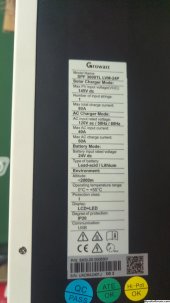Thersom1948
New Member
- Joined
- Apr 16, 2020
- Messages
- 60
Hi all,
I'm hoping @FilterGuy could review, since it is all based on his guides, but if anyone else could help that would be much appreciated!
I have read all of the grounding guides. and the Inverter Grounding Schemes. I am just hoping for a quick sanity check
1. I have a Growatt 24V SPF 3000TL LVM (Old Version)
2. I have a completely floating solar generator system (Will's "Handcart" style) with Eve cells and Overkill Solar BMS. Not in a vehicle.
3. I charge it from Non-GFCI shore power occasionally, but is not permanently installed.
4. I charge it from Honda EU2000i occasionally, but is not permanently installed
5. If/when power is out for a long time, I would charge it with solar panels, but are not permanently installed
After reading all of those guides my takeaway for ground safety are that I should:
A. Jump the AC-in and AC-out Neutral inside the Growatt (see attached pic with proposed jumper)
B. Use a Neutral/Ground plug adapter specifically and only for the Honda<>Growatt charging
C. If deploying solar panels, Bond all Panels and Growatt case to a single Earth ground. All Completely Off-Grid
Is that correct?
D. Bonus question: The guide says the Growatt has zero AC Ground/Neutral bond. Is that a safety risk for running the AC loads from the inverter when it is not connected to grid (or Honda with N/G plug)? Do I need to run all invert AC loads from the Neutral/Ground plug adapter too?
Thank you!

I'm hoping @FilterGuy could review, since it is all based on his guides, but if anyone else could help that would be much appreciated!
I have read all of the grounding guides. and the Inverter Grounding Schemes. I am just hoping for a quick sanity check
1. I have a Growatt 24V SPF 3000TL LVM (Old Version)
2. I have a completely floating solar generator system (Will's "Handcart" style) with Eve cells and Overkill Solar BMS. Not in a vehicle.
3. I charge it from Non-GFCI shore power occasionally, but is not permanently installed.
4. I charge it from Honda EU2000i occasionally, but is not permanently installed
5. If/when power is out for a long time, I would charge it with solar panels, but are not permanently installed
After reading all of those guides my takeaway for ground safety are that I should:
A. Jump the AC-in and AC-out Neutral inside the Growatt (see attached pic with proposed jumper)
B. Use a Neutral/Ground plug adapter specifically and only for the Honda<>Growatt charging
C. If deploying solar panels, Bond all Panels and Growatt case to a single Earth ground. All Completely Off-Grid
Is that correct?
D. Bonus question: The guide says the Growatt has zero AC Ground/Neutral bond. Is that a safety risk for running the AC loads from the inverter when it is not connected to grid (or Honda with N/G plug)? Do I need to run all invert AC loads from the Neutral/Ground plug adapter too?
Thank you!

Last edited:



